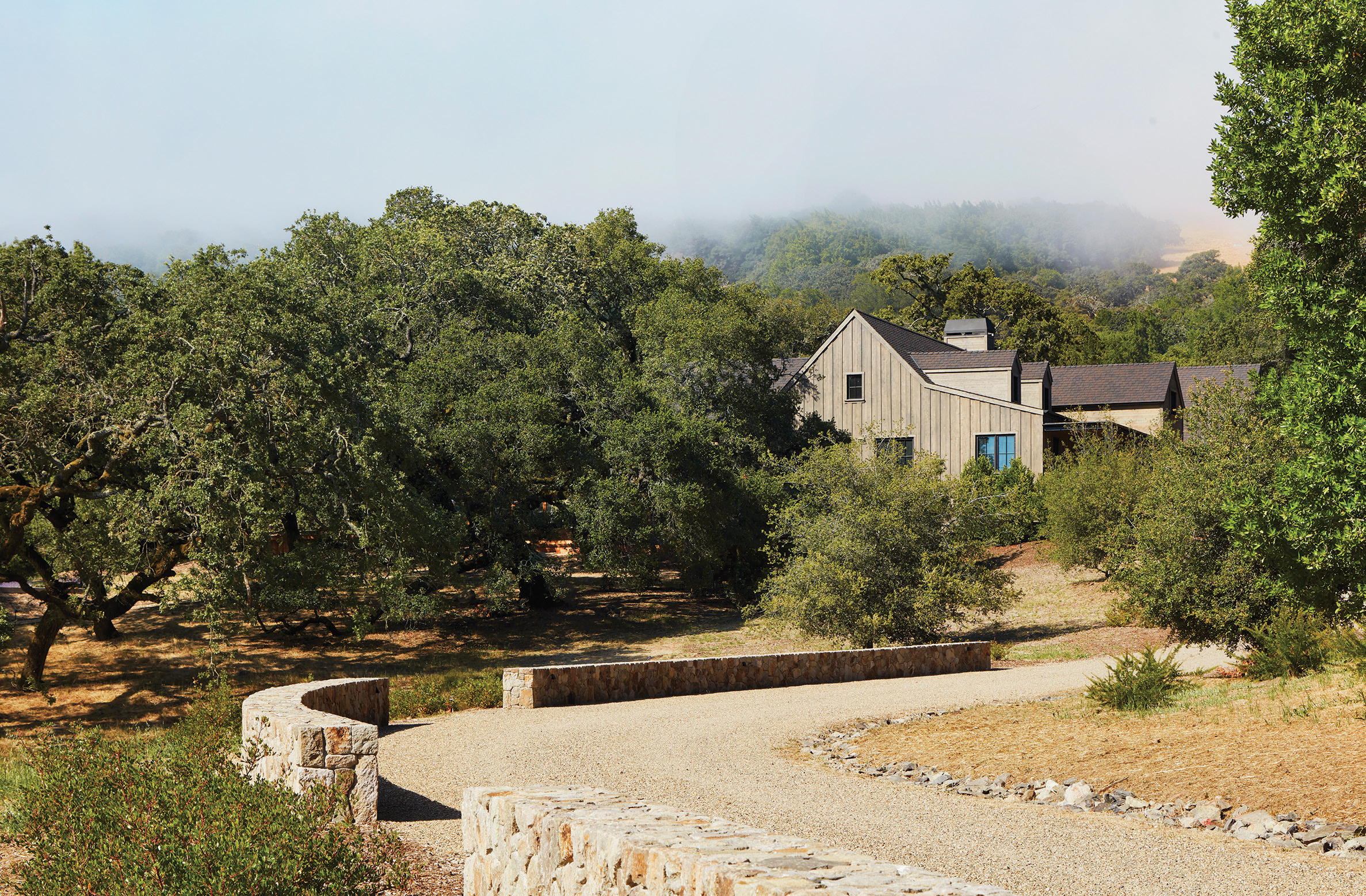
30 Apr RENDERING: THE ART OF OUTDOOR LIVING
The landscape around George Ranch in Sonoma is quintessentially Californian. Its rolling hills are studded with sculptural live oaks and teeming with birds and wildlife. Sun-drenched meadows contrast with fog-shrouded vineyards; intermittent glimpses of distant mountaintops appear as one travels curving country roads. In short, it is the perfect place to retreat and recharge in nature.
Landscape design in settings of such spectacular beauty calls for both vision and restraint. At the same time, the designer must craft a plan and select materials that are appropriate to place while uniquely fitted to the client and architecture.
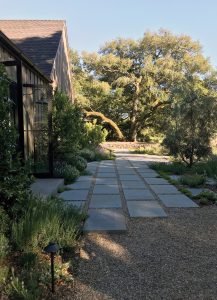
This bedroom terrace features open plantings of bluestone and thyme.
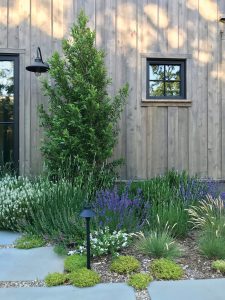
The “dry-lush” landscape softens the edges of the patio with olives (Olea europaea), Prunus caroliniana, Calamagrostis foliosa, salvia, lavender, and myoporum as ground cover.
When Katharine Webster first visited her clients’ new property, she was struck by its wide open expanses while also keenly aware of the need to balance their wishes with the sensitive nature and pristine condition of the land. It’s a balancing act, she explains. “With all my projects, there’s a discovery phase before the schematic design begins. After visiting the site and studying the architectural drawings, I work to understand the ecological systems, the program, and the client’s story. I want our projects to reflect who our clients are. I don’t want it to be about my design sensibility; it has to be about them.”
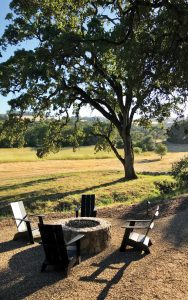
A fire pit sits at the edge of an open meadow planted with native grasses.
Her award-winning George Ranch project has been recognized for its embrace of outdoor living and thoughtful site planning, from the driveway layout to entertaining areas, pool, pool house, bocce court, archery range, and inviting pathways that lead guests on a journey of discovery. The scope included stone walls and patios, a dining terrace, pool deck, and gardens, among them a kitchen garden.
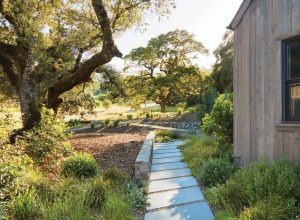
Pathways guided by sections of a stone wall lead through oak vistas.
“It was really about creating these nestled environments amongst ancient oak trees and meadows using plants and trees to soften and create flow between the spaces,” says Webster. “A variety of stone materials helps the built environment blend into the colors of the landscape and softens the edge between manmade and natural. The idea was that the property would mesh with the landscape as the landscape comes in close to the house.”
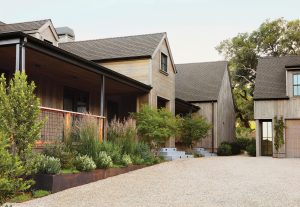
Simple Corten walls serve as a rustic-leaning retaining element for the grasses, salvia, and Westringia, which are repeated throughout the property. The front door is flanked by crepe myrtle trees.
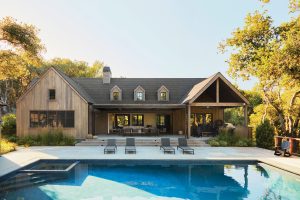
The pool and outdoor living area, bookended by mature oaks providing shade and form, is the perfect oasis for outdoor lounging and weekend entertaining.
Webster is well-positioned to create gardens in a wide variety of settings and ecosystems, having grown up on the East Coast and on an island in eastern Canada amongst a family dedicated to the decorative arts. She lived in Switzerland as a teenager, studied American Studies and Environmental Sculpture in Maine, and earned a Master of Landscape Architecture from Harvard’s Graduate School of Design. Her career began with installing the Shakespeare Garden in New York’s Central Park and continued with training under expert landscape architects on both coasts. Three decades in private practice have resulted in a portfolio of projects from California to the Hamptons.
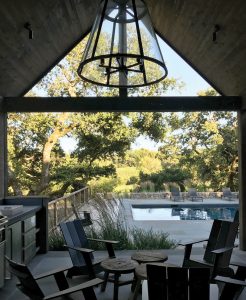
Classic wine country living offers shaded casual seating by the outdoor kitchen, with Westringia and Calamagrostis ‘Karl Foerster’ softening the distant views.
Webster’s approach to outdoor living is the product of a singular design sensibility with a wide-angle-lens approach combined with a deep understanding of plants, climate, and state-of-the-art materials. She is adept at transforming natural places into unique, sometimes whimsical venues and connecting interiors to integrated outdoor rooms that encourage flow. Her bespoke living spaces uniquely express each client’s dreams while making the most of a site’s attributes.
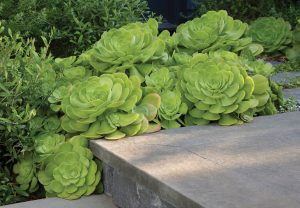
On a hillside in Sausalito, California, large florets of aeoniums hug an edge of basalt paving.
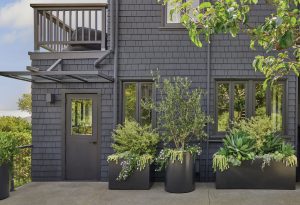
Webster designed custom steel planters for cascading displays of succulents.
Webster has also created a line of multifunctional accessories for Horchow and Neiman Marcus and designs unique environmental art pieces. Sustainably minded, she relishes finding new applications for cast-off materials found in stone yards or on job sites. Her 2025 San Francisco Decorator Showcase garden features reclaimed cobblestone, custom planters carved from discarded old-growth wood, and a limestone bar made from leftover quarried material.
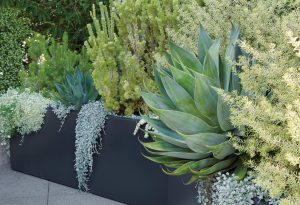
Each planter combines varied textures and shades of green to provide interest and depth.
Known for conceiving graceful solutions to environmental and logistical challenges, Webster threads together cohesive spaces with unexpected tones and textures, often within unique spatial constraints. For a home overlooking San Francisco Bay, she collaborated with the architect to transform a steep hillside overgrown with ivy that was lacking both a sense of arrival from the street and a celebration of its East Bay and San Francisco views. The structurally complicated job included reorienting the hillside staircase to create different experiences and vantage points and reimagining two outdoor entertainment areas.
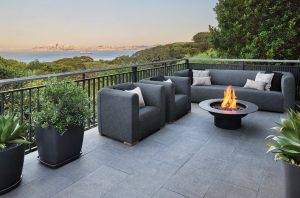
Basalt paving coordinates with a house overlooking San Francisco Bay; potted plants soften the setting without competing with the view.
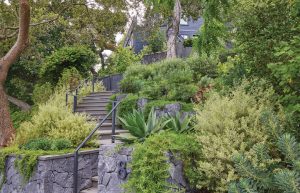
A stairway from the street to the house ascends through an oak canopy, creating a splendor of texture, form, and greenery.
This is a place of contrasts in textures and colors. In some areas, lines are clean and crisp; in others, plants encroach; they grow over the edges of the pathway or ooze from the corners of the staircase. Elevated planters of basalt located along the stairway add to the three-dimensionality of the experience. Webster designed a patio with East Bay views to deter freeloading deer, while an enclosed deck with city skyline views embraced a different plant palette and a more contemporary feel with stainless steel planters.
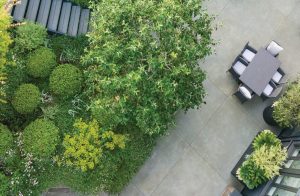
The sheltered kitchen patio becomes a retreat for immersion in nature.
“The textures and colors on this project were beautiful — and it’s a wonder, since it’s a shady environment,” she says. “We had sharp edges and soft edges. We had cascading plants and variegated plants. We had blues contrasting with silvers and greens. We used a very simple ground cover, choosing plants with different qualities and colors, ranging from deep green to Kelly green, with some variegated. The charcoal gray of the house provided a wonderful backdrop, which made the colors pop. We added succulents of varying textures too, some soft and dangly, some sharp and pointed, with the main flower color a soft purple. And we created different shade zones for the various levels of sun exposure, doing a careful dance underneath and around the canopies of the oaks, with their dappled shade and light.”
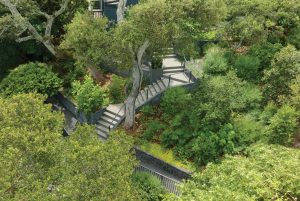
A bird’s eye view shows the oak canopy engulfing a hillside staircase.
Thoughtful, precise, carefully layered, and always attuned to color, texture, plant selection, placement, and view lines, each of Katharine Webster’s designs is born of people, palette, and place — an unfailing recipe for gracious indoor-outdoor living.
Chase Reynolds Ewald is a freelance writer, editor, and consultant who helps creatives craft their stories. A longtime contributor to Western Art & Architecture, her books include Wild Sugar with baker Lindsey Johnson and At Home in the Wine Country with Heather Sandy Hebert. Her titles with Montana photographer Audrey Hall include Cabin Style, American Rustic, and the multiaward-winning Bison. Their new book, Modern West, will be out in September.
Caitlin Atkinson is a photographer of places, spaces, and all things botanical. She is the author and photographer of Plant Craft: 30 Nature-Based Projects for Your Home, and her images have appeared in Architectural Digest, Gardens Illustrated, Elle Decor, Dwell, Martha Stewart Living, Better Homes and Gardens, and Sunset; caitlinatkinson.com.






No Comments